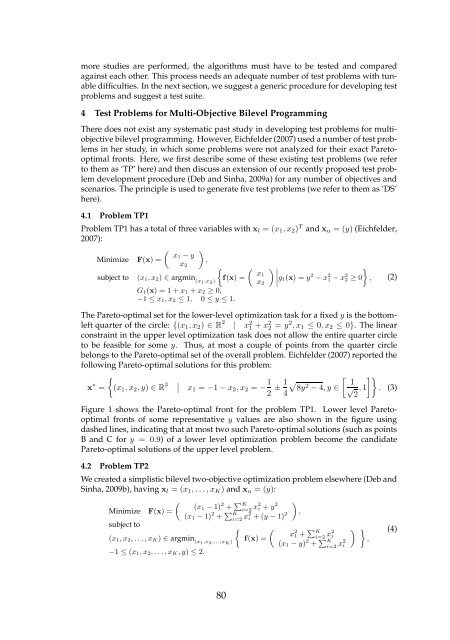Progressively Interactive Evolutionary Multi-Objective Optimization ...
Progressively Interactive Evolutionary Multi-Objective Optimization ...
Progressively Interactive Evolutionary Multi-Objective Optimization ...
You also want an ePaper? Increase the reach of your titles
YUMPU automatically turns print PDFs into web optimized ePapers that Google loves.
more studies are performed, the algorithms must have to be tested and compared<br />
against each other. This process needs an adequate number of test problems with tunabledifficulties.<br />
Inthenextsection,wesuggestagenericprocedurefordevelopingtest<br />
problems andsuggest a testsuite.<br />
4 Test Problemsfor<strong>Multi</strong>-<strong>Objective</strong> Bilevel Programming<br />
There does not exist any systematic past study in developing test problems for multiobjectivebilevelprogramming.However,Eichfelder(2007)usedanumberoftestproblems<br />
in her study, in which some problems were not analyzed for their exact Paretooptimal<br />
fronts. Here, we first describe some of these existing test problems (we refer<br />
tothemas ‘TP’ here)andthen discuss anextension ofour recentlyproposedtest problem<br />
development procedure (Deb and Sinha, 2009a) for any number of objectives and<br />
scenarios. Theprincipleisusedtogeneratefivetestproblems(werefertothemas‘DS’<br />
here).<br />
4.1 ProblemTP1<br />
ProblemTP1hasatotalofthreevariableswith xl = (x1, x2) T and xu = (y)(Eichfelder,<br />
2007):<br />
<br />
x1 − y<br />
Minimize F(x) =<br />
,<br />
x2<br />
<br />
<br />
g1(x) = y 2 − x 2 1 − x 2 <br />
2 ≥ 0 , (2)<br />
subject to (x1, x2) ∈ argmin (x1,x2)<br />
G1(x) = 1 + x1 + x2 ≥ 0,<br />
−1 ≤ x1, x2 ≤ 1, 0 ≤ y ≤ 1.<br />
<br />
x1<br />
f(x) =<br />
x2<br />
ThePareto-optimalsetforthelower-leveloptimizationtaskforafixed y is thebottomleft<br />
quarter of the circle: {(x1, x2) ∈ R 2<br />
| x2 1 + x22 = y2 , x1 ≤ 0, x2 ≤ 0}. The linear<br />
constraint in the upper level optimization task does not allow the entire quarter circle<br />
to be feasible for some y. Thus, at most a couple of points from the quarter circle<br />
belongstothePareto-optimalsetoftheoverallproblem. Eichfelder(2007)reportedthe<br />
following Pareto-optimalsolutions forthis problem:<br />
x ∗ <br />
= (x1, x2, y) ∈ R 3<br />
<br />
x1 = −1 − x2, x2 = − 1 1<br />
<br />
1<br />
± 8y2 − 4, y ∈ √2 , 1 . (3)<br />
2 4<br />
Figure 1 shows the Pareto-optimal front for the problem TP1. Lower level Paretooptimal<br />
fronts of some representative y values are also shown in the figure using<br />
dashedlines, indicating thatatmost twosuchPareto-optimalsolutions (suchaspoints<br />
B and C for y = 0.9) of a lower level optimization problem become the candidate<br />
Pareto-optimalsolutions ofthe upperlevel problem.<br />
4.2 ProblemTP2<br />
Wecreatedasimplisticbileveltwo-objectiveoptimizationproblemelsewhere(Deband<br />
Sinha,2009b),having xl = (x1, . . . , xK) and xu = (y):<br />
<br />
Minimize F(x) =<br />
subjectto<br />
(x1, x2, . . . , xK) ∈ argmin (x1,x2,...,x K )<br />
−1 ≤ (x1, x2, . . . , xK, y) ≤ 2.<br />
(x1 − 1) 2 + K<br />
i=2 x2 i + y 2<br />
(x1 − 1) 2 + K<br />
i=2 x2 i + (y − 1) 2<br />
80<br />
<br />
<br />
f(x) =<br />
<br />
,<br />
x 2 1 + K<br />
i=2 x2 i<br />
(x1 − y) 2 + K<br />
i=2 x2 i<br />
<br />
,<br />
(4)
















